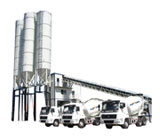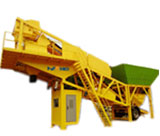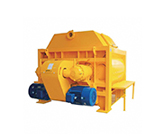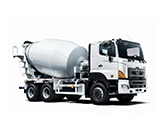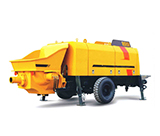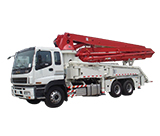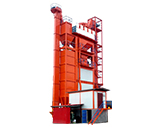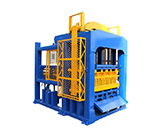Engineering Concrete Batching Plant
2025.07.30
An engineering concrete batching plant is a complete set of equipment that produces custom concrete for construction projects. It combines raw materials such as sand, gravel, cement, fly ash, water, and even additives in precise proportions, mixing them using specialized machinery to produce concrete ready for pouring. An engineering concrete batching plant is an automated equipment that integrates raw material storage, metering, and mixing. Its core function is to mix sand, gravel aggregate, cement, fly ash, water, and admixtures according to preset ratios to produce a concrete mixture that meets the project's design strength and workability requirements. It is a core piece of concrete production equipment in modern construction projects.


Production capacity of engineering concrete batching plant is divided into different ranges based on project scale:
- Small concrete batching plants:
With a theoretical hourly output of 25-50 m³, suitable for low-intensity projects such as rural infrastructure and small industrial plants;
- Medium concrete batching plants:
With a theoretical hourly output of 50-120 m³/h, primarily serving medium-sized projects such as urban housing construction, municipal roads, and ordinary bridges;
- Large concrete batching plants:
With a capacity of 120-240 m³/h and above, suitable for high-intensity, continuous construction needs such as high-speed rail hubs, large-scale water conservancy projects (such as hydropower stations and dams), and super-high-rise buildings. Some extra-large plants can exceed 300 m³/h.
Common models of engineering concrete batching plant follow industry-standard naming conventions, with theoretical hourly output as the core identifier, such as HZS25, HZS50, HZS120, and HZS240. "HZS" stands for the pinyin abbreviation for "concrete mixing plant," and the suffix number represents the theoretical hourly output (in m³). For example, HZS120 concrete batching plant is widely used in subway projects, cross-river bridges, and other applications requiring high concrete supply, while HZS25 concrete batching plant is more commonly found in projects such as rural road hardening and small water conservancy ditches.
The system of engineering concrete batching plant is structured as a modular, coordinated system:
- Batching System:
Consists of aggregate silos and electronic weighing scales, ensuring precise mixing of sand and gravel (measurement error ≤ ±1%);
- Powder Storage System:
Includes closed cement silos and fly ash silos, equipped with level meters for real-time storage monitoring. Each silo typically has a capacity of 50-300 tons;
- Conveying System:
Screw conveyors transport powders, while belt conveyors transport aggregates, ensuring efficient material flow;
- Mixing Unit:
The mainstream is a twin-shaft forced-type mixer, which achieves three-dimensional mixing of materials through high-speed rotating blades. A mixing cycle of 30-90 seconds ensures a homogeneous mixture;
- Control System:
An automated control unit based on PLC technology allows for dozens of preset recipes, real-time monitoring of the entire process from metering, mixing, and unloading, and supports data traceability;
- Auxiliary Systems:
Includes water storage tanks, admixture metering devices, and a compressed air system, completing the production closed loop.
Core advantages of engineering concrete batching plant lie in project adaptability and technological advancement:
1. Quality Stability:
Through automated metering and programmed control, key parameters such as the water-binder ratio and aggregate grading are strictly controlled, avoiding mix deviations caused by manual mixing and ensuring that concrete strength, slump, and other indicators meet specified standards.
2. Production Efficiency:
With strong continuous operation capabilities, a medium-sized station can achieve an average daily production capacity of 800-1500 m³, significantly shortening the project pouring cycle.
3. Cost Control:
Automation reduces labor input by over 30%, enclosed storage reduces powder loss to less than 1%, and the wastewater recovery system enables water recycling.
4. Functional Scalability:
By adjusting parameters such as admixture type and dosage, specialized concretes such as impermeability, frost resistance, and early strength can be produced to meet differentiated project requirements.
5. Environmental Compliance:
A standard pulse dust collector controls powder dust, and the wastewater treatment unit achieves solid-liquid separation, complying with regulations such as the "Environmental Noise Emission Standard for Construction Sites."
Applications of engineering concrete batching plant cover the entire civil engineering sector:
- Building construction:
Used for casting structures such as foundation cushions, frame beams and columns, and floor slabs;
- Transportation engineering:
Precasting of highway pavement bases, railway sleepers, and bridge box girders;
- Water conservancy projects:
Embankment anti-seepage structures, channel linings, and pump station concrete pouring;
- Municipal engineering:
Underground utility corridors, sewage treatment plant tanks, and urban plaza hardening;
- Special projects:
Concrete supply for mine tunnel support, airport runways, and port storage yards.
The core value of an engineering concrete batching plant lies in transforming discrete raw materials into standardized building materials, providing a foundation for structural safety and construction efficiency.

